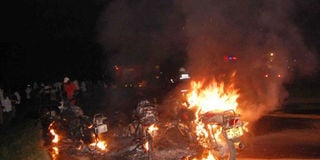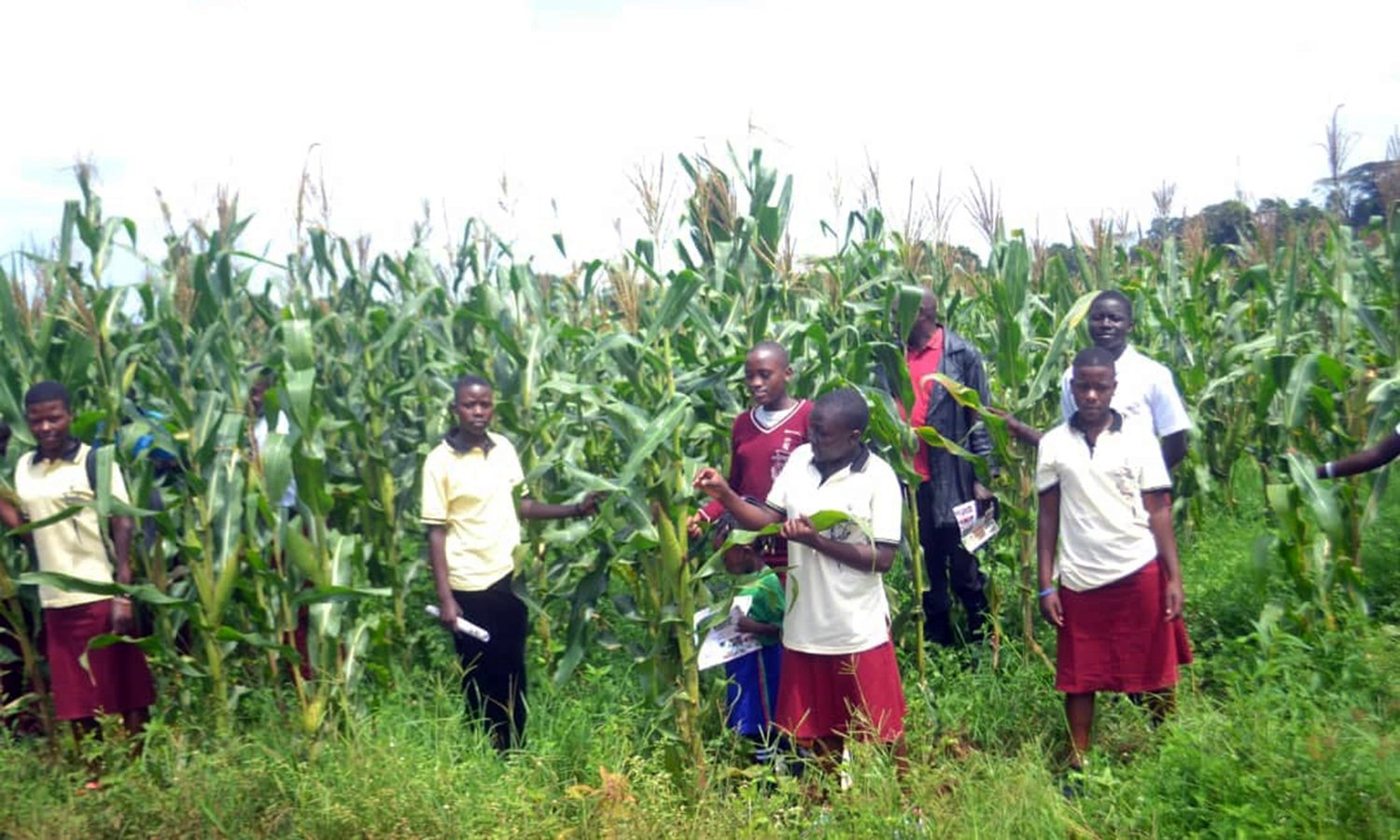Namungoona inferno: Kampala city still sitting on a fuel bomb

Some of the motorcycles that were burnt as their riders siphoned fuel from the tanker at the site of the inferno in Namungoona. File photo
What you need to know:
Still being careless. As we mark a year since the tragic Namungoona incident that claimed scores of lives, our reporters FREDERIC MUSISI & FARAHANI MUKISA look at the city and discover not much has been done to better the situation and avoid any such accidents in future.
Kampala- Kampala’s mess from traffic gridlock to squalid slums peppered with high crime rates, manifest in violent burglaries and individuals being waylaid and bludgeoned to death with metal bars, make the capital a death trap of sorts.
Now there is a new layer of risk; a man-induced muddle that casts every dweller into potential harm’s way, whether one is walking, driving or on the back of the ever-present boda bodas.
It is the inappropriate, even dangerous positioning of a high number of fuel stations in and around the central business district.
The city is overwhelmed with these, majority literally sitting on reserves of the narrow roads while tens pop out from crowded residential neighbourhoods.
On paper as per government policy, gas stations holding thousands of litres of fuel in underground reservoirs, are supposed to be sited at least a kilometre apart. On the ground, they are a few hundred metres close with some located at traffic jam-prone intersections.
Police have called the crowding a “time-bomb”, a reference to potential huge destruction to life and property if the fillings stations were to catch fire, say, during rush-hour. The country has recorded mysterious fires that in the past few years killed dozens of students and destroyed the Kasubi tombs, a World Heritage site.
This risk of petro-fires could not be more telling than today, June 30, the first anniversary of a fuel tanker inferno on the Northern Bypass in Namungoona, north-west of Kampala, which killed some 30 or so people in what investigators concluded, was a self-inflicted accident.
Majority victims were siphoning fuel from a tanker stuck on the thoroughfare.
Intelligence agencies warn that terrorists plan to blow up fuel tankers in transit or set alight teeming fuel containers, prompting police to begin escort services for the trucks from border custom to delivery points.
Energy Ministry officials and their counterparts in City Hall as well as the environmental watchdog, National Environment Management Authority (Nema), acknowledge the random location of these fuel stations threaten public safety but each points an accusing finger at the other on who is responsible.
In the east of Kampala, a huge fuel depot sits in a crowded residential neighbourhood and just few metres away from the traffic laden Jinja highway.
According to Uganda National Bureau of Standards (UNBS) guidelines, a fuel station must be located at least 1,000 metres away from another, 15 metres from a habitat.
“Saying that fuel stations in Kampala are many is an exaggeration because there is no binding evidence to prove they have a potential threat,” the senior spokesperson in the ministry, Mr Matovu Bukenya, said. Ading: “We have however stopped licencing more fuel stations in Kampala since 2011.”
There is no problem
Mr Bukenya, maintained that there are only 105 fuel stations in Kampala. The divisions most crowded with fuel stations are Rubaga, Kawempe and Makindye respectively.
Uganda until 1994, had only six fuel distributors, namely Upet, Agip, Gapco, Shell, Total and Caltex but the liberalisation of the market brought on board more players and they currently estimated over 30.
A 2011 report from the Ministry of Energy indicates that of the 730 fuel stations in the country, 220 were located in Kampala. But from the current figures provided there is an indication that numbers have gone down. This does not include the number of single pump stations.
The ministry also believes that (even if), this big number pose no threat because most fuel stations have underground tanks and this surge indicates growth in the consumption rate and that it has doubled compared to ten years back which keeps business afloat.
“Sixty per cent of fuel station business is in Kampala, which attracts more players thus reduces the average pay for fuel product, which benefits go back to the communities,” says Mr Bukenya noted, adding that for the many that clogged on one proximity, several have closed shop due to failure to keep up business even at breakeven point.”
But, “we started closing all illegal stations and by close of August we shall have wiped out all those that don’t meet standards.”
The other growing concern is on fuel stations in ungazetted places such as residential areas, congested areas like slums and business centres as seen in areas like Bwaise and Kawempe, which pause serious safety threats in case of a fire outbreak.
A glowing example is the large fuel depot for Mogas Fuel, one of the distributors in Banda, on the outskirts of the city centre. The depot has about five huge storage tanks and is surrounded by a huge slum stretch.
Attempts to reach officials at the company for comment on safety precautions were futile for several days while officials from other large fuel distributors also declined to comment on the matter.
Two distributors, Vivo Energy formerly Shell and Total gazatted their fuel reserves in one industrial area, which the ministry says eases emergency supplies and enables combined enjoyment of similar facilities such as railways lines.
The executive director of the National Environment Management Authority (NEMA), Dr Tom Okurut, maintained that licensing is conducted by the Ministry and they have little role to play in the matter but “sometimes investors come to us with approvals already from other bodies.”
The Police in early 2000s when fuel stations were rapidly developing described them as a “time bomb.”
Mr Joseph Mawanda, a resident of Kawempe who operates a business near a busy fuel station on Bombo Road, told the Daily Monitor, “Of course, we live in fear everyday but since those in charge of such things live in upscale residences, they are not bothered at all.”
But as a measure, both KCCA and the ministry say they have stopped the licencing of fuel stations around the city. They all blame KCCA’s predecessor, the Kampala City Council (KCC) for the stations already congesting the city, especially those that came before the enactment of the Petroleum Supply General Regulations Act in 2009.
The ministry, according to the law, retains the power to licence any fuel station and they ought to be located in industrial or commercial zones.
But in country where heavy fuel tracks overturn now and then or even crash and residents quickly hurry to the scene to scoop free fuel, more public awareness is still required and the safety precautions on paper implemented and tightened but otherwise so far no lessons have been learned from fuel accidents.
PREVIOUS FUEL ACCIDENTS
December 2001: 90 died when a fuel tanker caught fire in Buseesa, Iganga District.
February 2005: 45 people burned to death after a minibus, a fuel tanker and a Suzuki car collided at Lwankima in Mabira Forest.
July 30, 2006: 30 people were killed when a fuel tanker collided with Mitsubishi Rosa minibus at Kitega hill on Kampala-Jinja Road.
August 2006: 27 passengers died when their minibus collided head-on with a fuel tanker on the Kampala-Jinja road, 3km from Lugazi town; another three trying to steal fuel from the tanker were killed by the petrol fumes.
December 15, 2004: 12 people died when a fuel tanker, two trailers and a pick-up truck collided on the Jinja-Iganga Road.



